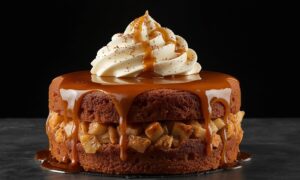Some nights don’t call for fancy cooking, they call for rescue food. Simple Salmon Chowder is that kind of lifesaver: warm, hearty, and built from what you already have on hand. You know that moment when the day runs too long, your stomach growls louder than your thoughts, and dinner feels like one more impossible task? That’s exactly when this chowder comes to the table, wrapping you up in comfort without slowing you down.
I stumbled into this recipe on one of those evenings. No big shopping trip, no perfect lineup of ingredients. Just me, a leftover salmon fillet, a few potatoes, and the stubborn need to eat something better than bland takeout. The kitchen was quiet except for butter sizzling in a pot, garlic softening into that rich golden perfume, and broth bubbling its way into something I didn’t even know I needed.
What came out of that pot was the kind of meal that feels both nostalgic and new: creamy but not heavy, briny yet buttery, with salmon flaking into tender bites that soak up every spoonful of flavor. It’s cozy enough for a rainy night but bold enough to make you forget it started with pantry scraps.
And that’s why this recipe works. Simple Salmon Chowder isn’t just easy, it’s adaptable, crave worthy, and guaranteed to hit the spot. In this post, I’ll show you exactly how to bring it together step by step, plus a few fun variations to keep it fresh. Trust me, make it once, and it’ll become your weeknight go to.
Why This Simple Salmon Chowder Changes Everything

Here’s what makes this particular version special, we’re not messing around with complicated roux or spending an hour babysitting a pot. This chowder comes together in about 30 minutes, uses ingredients you can actually find at your regular grocery store, and somehow tastes like you’ve been simmering it all day.
The secret? We’re building layers of flavor quickly and letting each ingredient shine without getting lost in the shuffle. Fresh salmon that flakes perfectly. Vegetables that still have some bite. A broth that’s rich but not heavy. And yeah, we’re gonna talk about that cream situation because it’s not what you’d expect.
The Ingredients That Make Magic Happen
Let me walk you through this lineup like we’re shopping together:
For the base:
- 1 tablespoon olive oil
- 2 tablespoons butter (the real stuff, please)
- 1 medium onion, diced small
- 2 celery stalks, chopped fine
- 3 medium carrots, cut into small cubes
- 3 cloves garlic, minced (or that jarred stuff if life’s being crazy)
The star of the show:
- 1 pound salmon fillet, skin removed, cut into 1 inch chunks
- 2 medium Yukon Gold potatoes, peeled and cubed
- 4 cups low sodium chicken broth (or vegetable if you’re keeping it lighter)
- 1 cup whole milk
- 1/2 cup heavy cream (trust me on this ratio)
Flavor boosters:
- 2 bay leaves
- 1 teaspoon dried dill (or 1 tablespoon fresh)
- 1/2 teaspoon smoked paprika
- Salt and white pepper to taste
- 2 tablespoons fresh parsley for finishing
- Lemon wedges for serving
Now, about those smart swaps I promised. Can’t do dairy? Coconut milk works beautifully here, use the full fat kind and add it at the very end. No salmon? Cod or halibut will play nice, or even canned salmon if that’s what you’ve got (just drain it well). Living somewhere without Yukon Golds? Any waxy potato works, but skip the russets, they’ll turn your chowder into wallpaper paste.
Here’s a trick most recipes won’t tell you: buy your salmon from the seafood counter, not pre packaged. Ask them to remove the skin for you. It’s free, saves you time, and those folks know what they’re doing.
Step by Step Magic

Start with your foundation
Heat that olive oil and butter in a large, heavy bottomed pot over medium heat. When the butter stops foaming, you’re ready for the vegetables. Toss in the onion, celery, and carrots. Let them get friendly for about 5 minutes until the onion turns translucent.
Don’t rush this part. Those vegetables are building the flavor foundation for everything that comes after. You want them softened but not mushy, they’ll continue cooking as we add other ingredients.
Add the garlic last
This is crucial because garlic burns faster than you think, and burnt garlic will make your whole chowder taste bitter. Stir it in, let it get fragrant for about 30 seconds, then move on quickly.
Time for the potatoes and broth
Add those cubed potatoes and pour in the chicken broth. Toss in your bay leaves and bring everything to a gentle boil. Here’s where patience pays off, simmer this for about 10 minutes until the potatoes are just tender when you poke them with a fork.
The Salmon moment
This is where people usually panic, but don’t. Gently nestle those salmon chunks into the simmering broth. They’re gonna cook fast, we’re talking 3 to 4 minutes max. The salmon’s done when it flakes easily but still holds together. Overcooked salmon turns into fish mush, and nobody wants that.
Cream it up carefully
Remove the pot from heat first, this prevents curdling. Slowly stir in the milk, then the cream. Add your dill, smoked paprika, salt, and white pepper. Taste as you go because everyone’s salt tolerance is different.
Put it back on the lowest heat possible just to warm through. Don’t let it boil once you’ve added the dairy, or you’ll end up with cottage cheese floating in your soup.
The Science Behind the Sizzle
Let’s talk about why this method works so well. When you sauté those vegetables first, you’re creating something called the mirepoix, it’s the flavor base that French cooks swear by. The gentle cooking releases sugars and creates those deeper, more complex flavors.
The order matters too. Garlic goes in last because it contains compounds that break down quickly under heat. Add it too early, and you lose that bright, aromatic punch. Add it at the right moment, and it blooms throughout the entire dish.
Here’s the dairy science part: we add milk before cream because milk has more water content and integrates more easily into the hot broth. The cream comes second, providing richness without overwhelming the delicate salmon flavor. Taking the pot off heat first prevents the proteins in the dairy from seizing up and curdling.
That smoked paprika? It’s not just for color. It adds a subtle depth that makes people go “what IS that flavor?” without being able to pinpoint it. It’s like a secret handshake between you and anyone who tastes your chowder.
Making It Beautiful and Delicious
Presentation matters, even for comfort food. Ladle your Simple Salmon Chowder into warmed bowls, and yes, warming the bowls makes a difference. Just run them under hot water and dry them quickly.
Finish each bowl with a sprinkle of fresh parsley and a tiny drizzle of good olive oil. The oil creates these beautiful little puddles on the surface that catch the light. Serve those lemon wedges on the side, a little squeeze brightens everything up and cuts through the richness.
This chowder plays beautifully with crusty sourdough bread, but honestly? Those butter crackers you probably have in your pantry work just fine too. Sometimes simple is exactly what you need.
If you’re feeling fancy, a small side salad with something acidic, arugula with lemon vinaigrette, maybe, balances out the richness perfectly. Wine wise, a crisp Sauvignon Blanc or even a light Pinot Noir works wonderfully.
Bringing It All Together

Your Simple Salmon Chowder should be creamy without being heavy, with distinct pieces of tender salmon and vegetables in every spoonful. The broth should coat a spoon lightly but not feel thick or gluey. Each bite should taste clean and bright, with that wonderful warmth that only good chowder can deliver.
The beautiful thing about this recipe is how forgiving it is once you understand the basic technique. Too thick? Add more broth. Want it richer? An extra splash of cream won’t hurt. Feeling adventurous? A handful of corn or some crispy bacon bits can take it in totally new directions.
Make this recipe your own. Start with these proportions, then adjust based on what your family loves. Maybe they prefer more vegetables, or less cream, or a different herb altogether. The technique stays the same, but the flavors can be entirely yours.
This Simple Salmon Chowder will become one of those recipes you find yourself making over and over, especially when the weather turns cool or when you need something that feels like a warm hug in a bowl.
Frequently Asked Questions
Can I make Simple Salmon Chowder ahead of time?
You absolutely can, but here’s the trick: make everything up to adding the dairy, then stop. Store that base in the fridge for up to two days. When you’re ready to serve, reheat gently and add your milk and cream at the very end. This prevents the dairy from separating when you reheat it.
What’s the best way to reheat leftover chowder?
Low and slow is the name of the game. Use the lowest heat setting on your stove and stir frequently. If it looks too thick, add a splash of broth or milk to loosen it up. Never microwave it, the dairy will separate and the salmon will turn rubbery.
Can I freeze salmon chowder?
Honestly? I wouldn’t recommend it. Dairy based soups don’t freeze well, and the salmon texture suffers. Instead, make smaller batches more frequently. It only takes 30 minutes anyway, and fresh is always better.
My chowder turned out too thin, how do I fix it?
Mix a tablespoon of cornstarch with two tablespoons of cold milk until smooth, then whisk it into your simmering chowder. Let it cook for a couple minutes to thicken. Alternatively, mash a few of the potato pieces against the side of the pot, they’ll break down and naturally thicken the broth.
What if I can’t find fresh salmon?
Frozen salmon works perfectly fine, just thaw it completely and pat it dry before adding to the chowder. Canned salmon is another option, though the texture will be different. Drain it well and add it at the very end, just to warm through since it’s already cooked.

Swiftly Captions by Tina Smith — Quick, flavorful food recipes made simple, bringing fresh inspiration to your kitchen every day






